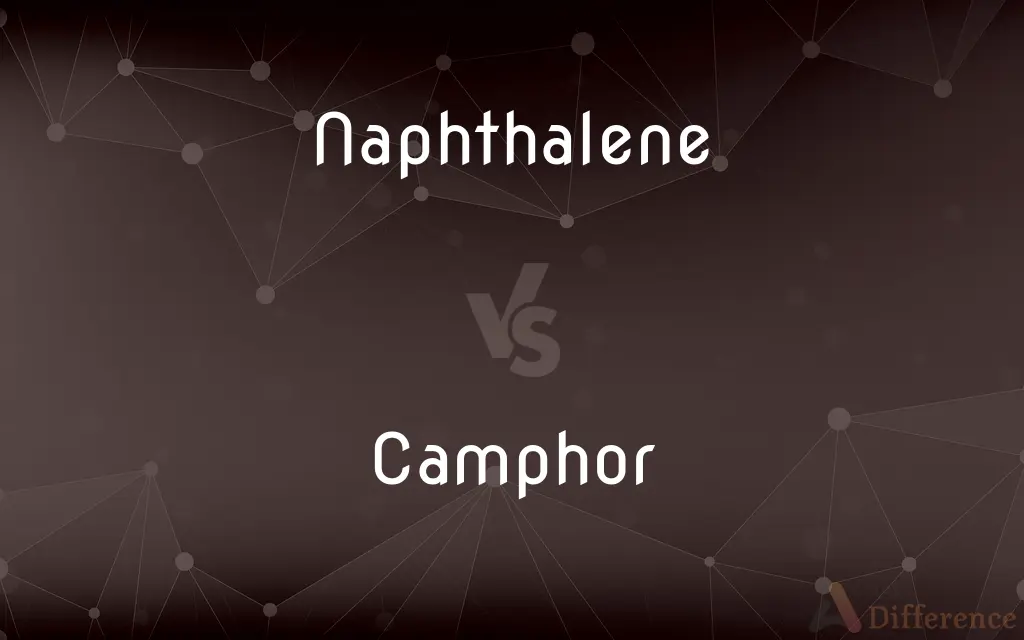Naphthalene vs. Camphor — What's the Difference?
By Tayyaba Rehman — Updated on September 18, 2023
Naphthalene is a white crystalline compound mainly used in mothballs, while Camphor is a flammable white substance with a strong aroma, used in medicinal products and plastics.

Difference Between Naphthalene and Camphor
Table of Contents
ADVERTISEMENT
Key Differences
Naphthalene and Camphor are both organic compounds recognized for their distinct characteristics and uses. Naphthalene is a hydrocarbon commonly associated with mothballs and is known for its pungent smell that repels insects. In contrast, Camphor is often identified by its strong aroma and is frequently used in medicinal and therapeutic products.
Historically, Naphthalene has been employed as an insect repellent, especially against moths that damage clothing. The small white balls made of Naphthalene disintegrate over time, releasing its typical smell. On the other hand, Camphor has a long history in traditional medicine, particularly in balms and liniments for its cooling sensation and pain relief properties.
Chemically speaking, Naphthalene is a polycyclic aromatic hydrocarbon composed of two fused benzene rings. It's derived from coal tar or petroleum. Camphor, on the other hand, is obtained from the wood of the camphor tree and is a terpenoid, meaning it has a structure derived from isoprene units.
While Naphthalene primarily serves a functional role as a repellent, Camphor finds diverse applications. Beyond medicine, Camphor is used in culinary practices, religious rituals, and even in the manufacture of some plastics due to its plasticizing properties.
In summary, while both Naphthalene and Camphor are organic compounds with strong odors, they differ in origin, chemical structure, and applications. Naphthalene is primarily known for its use in mothballs, whereas Camphor has varied uses ranging from medicine to plastics.
ADVERTISEMENT
Comparison Chart
Primary Use
Moth repellent.
Medicine and plastics.
Origin
Derived from coal tar or petroleum.
Obtained from the wood of the camphor tree.
Chemical Structure
Polycyclic aromatic hydrocarbon.
Terpenoid.
Associated Smell
Pungent, mothball-like odor.
Strong, aromatic odor.
Grammatical Use
Primarily used as a noun.
Commonly used as a noun, but can also describe its derived scent.
Compare with Definitions
Naphthalene
A hydrocarbon derived from coal tar or petroleum.
Naphthalene is often produced during coal distillation.
Camphor
A flammable white substance with medicinal properties.
She applied a Camphor balm to soothe her aching muscles.
Naphthalene
A white crystalline compound used primarily in mothballs.
She placed Naphthalene balls in her closet to prevent moth damage.
Camphor
Known for its strong aromatic odor.
The distinct smell of Camphor filled the room.
Naphthalene
A repellent against moths and other insects.
Storing clothes with Naphthalene ensures they remain insect-free.
Camphor
A plasticizing agent in the manufacture of plastics.
Camphor was once a primary plasticizer for celluloid.
Naphthalene
Substance known for its characteristic pungent odor.
The scent of Naphthalene reminds me of my grandmother's cupboard.
Camphor
Obtained from the camphor tree and used in various products.
The Camphor tree is native to Asia.
Naphthalene
Naphthalene is an organic compound with formula C10H8. It is the simplest polycyclic aromatic hydrocarbon, and is a white crystalline solid with a characteristic odor that is detectable at concentrations as low as 0.08 ppm by mass.
Camphor
Used in culinary practices and religious rituals.
Some cultures use Camphor in traditional dishes.
Naphthalene
A white crystalline aromatic compound, C10H8, derived from coal tar or petroleum and used in manufacturing dyes, moth repellents, and explosives and as a solvent. Also called tar camphor.
Camphor
Camphor () is a waxy, flammable, transparent solid with a strong aroma. It is a terpenoid with the chemical formula C10H16O. It is found in the wood of the camphor laurel (Cinnamomum camphora), a large evergreen tree found in East Asia; and in the related kapur tree (Dryobalanops sp.), a tall timber tree from South East Asia.
Naphthalene
A white crystalline hydrocarbon manufactured from coal tar; used in mothballs.
Camphor
A fragrant white or colorless crystalline ketone, C10H16O, obtained naturally from the wood of the camphor tree or synthesized from pinene and used as an insect repellent, in the manufacture of film, plastics, lacquers, and in medicine chiefly in external preparations to relieve mild pain and itching.
Naphthalene
(organic compound) An aromatic bicyclic hydrocarbon, C10H8; an acene containing two fused benzene rings.
Camphor
(organic compound) A white transparent waxy crystalline isoprenoid ketone, 1,7,7-trimethylbicyclo[2.2.1]heptan-2-one, with a strong pungent odour, used in pharmacy.
Naphthalene
A white crystalline aromatic hydrocarbon, C10H8, analogous to benzene, and obtained by the distillation of certain bituminous materials, such as the heavy oil of coal tar. It is the type and basis of a large number of derivatives among organic compounds. Formerly called also naphthaline.
Camphor
A tough, white, aromatic resin, or gum, obtained from different species of the Laurus family, esp. from Cinnamomum camphara (the Laurus camphora of Linnæus.). Camphor, C10H16O, is volatile and fragrant, and is used in medicine as a diaphoretic, a stimulant, or sedative.
Naphthalene
A white crystalline strong-smelling hydrocarbon made from coal tar or petroleum and used in organic synthesis and as a fumigant in mothballs
Camphor
Originally, a gum resembling ordinary camphor, obtained from a tree (Dryobalanops aromatica formerly Dryobalanops camphora) growing in Sumatra and Borneo; now applied to its main constituent, a terpene alcohol obtainable as a white solid C10H18O, called also Borneo camphor, Malay camphor, Malayan camphor, camphor of Borneo, Sumatra camphor, bornyl alcohol, camphol, and borneol. The isomer from Dryobalanops is dextrorotatory; the levoratatory form is obtainable from other species of plants, and the racemic mixture may be obtained by reduction of camphor. It is used in perfumery, and for manufacture of its esters. See Borneol.
Naphthalene
An ingredient used in various industrial applications.
The chemical industry uses Naphthalene in the production of some dyes.
Camphor
To impregnate or wash with camphor; to camphorate.
Camphor
A resin obtained from the camphor tree; used in making celluloid and liniment
Common Curiosities
Are Naphthalene and Camphor safe to consume?
No, both are toxic if ingested and can be harmful.
Where is Naphthalene derived from?
It's derived from coal tar or petroleum.
Is Camphor natural?
Yes, it's primarily obtained from the wood of the camphor tree.
Are there other uses for Camphor beyond medicine?
Yes, Camphor is used in culinary practices, religious rituals, and in manufacturing certain plastics.
Can I use Camphor as a moth repellent like Naphthalene?
While Camphor has repellent properties, it's best to use products specifically designed for their purpose.
Can Camphor be used for pain relief?
Yes, Camphor is often found in balms and liniments for its cooling and pain-relieving properties.
Why do mothballs smell so distinct?
That distinct smell comes from Naphthalene, the primary component of most mothballs.
Is Camphor flammable?
Yes, Camphor is flammable.
Why is Naphthalene used in industrial applications?
It's used in the production of certain dyes and other chemicals.
Is Naphthalene harmful to clothes?
No, its primary use is to protect clothes from moths.
What does Camphor smell like?
It has a strong, aromatic odor often described as minty or medicinal.
Can Naphthalene and Camphor be used interchangeably?
No, they have different chemical structures and uses.
Are there any health concerns associated with Camphor?
Yes, in large quantities or if ingested, it can be toxic.
Can I replace Naphthalene with something less pungent?
Yes, there are alternatives like cedarwood which repel moths with a milder scent.
How does Naphthalene repel moths?
Its strong pungent odor is disliked by moths, keeping them away.
Share Your Discovery

Previous Comparison
Torn vs. Teared
Next Comparison
Mydriasis vs. MiosisAuthor Spotlight
Written by
Tayyaba RehmanTayyaba Rehman is a distinguished writer, currently serving as a primary contributor to askdifference.com. As a researcher in semantics and etymology, Tayyaba's passion for the complexity of languages and their distinctions has found a perfect home on the platform. Tayyaba delves into the intricacies of language, distinguishing between commonly confused words and phrases, thereby providing clarity for readers worldwide.















































